Caixin Kang
From reactive to cognitive: brain-inspired spatial intelligence for embodied agents
Aug 24, 2025Abstract:Spatial cognition enables adaptive goal-directed behavior by constructing internal models of space. Robust biological systems consolidate spatial knowledge into three interconnected forms: \textit{landmarks} for salient cues, \textit{route knowledge} for movement trajectories, and \textit{survey knowledge} for map-like representations. While recent advances in multi-modal large language models (MLLMs) have enabled visual-language reasoning in embodied agents, these efforts lack structured spatial memory and instead operate reactively, limiting their generalization and adaptability in complex real-world environments. Here we present Brain-inspired Spatial Cognition for Navigation (BSC-Nav), a unified framework for constructing and leveraging structured spatial memory in embodied agents. BSC-Nav builds allocentric cognitive maps from egocentric trajectories and contextual cues, and dynamically retrieves spatial knowledge aligned with semantic goals. Integrated with powerful MLLMs, BSC-Nav achieves state-of-the-art efficacy and efficiency across diverse navigation tasks, demonstrates strong zero-shot generalization, and supports versatile embodied behaviors in the real physical world, offering a scalable and biologically grounded path toward general-purpose spatial intelligence.
Towards NSFW-Free Text-to-Image Generation via Safety-Constraint Direct Preference Optimization
Apr 19, 2025Abstract:Ensuring the safety of generated content remains a fundamental challenge for Text-to-Image (T2I) generation. Existing studies either fail to guarantee complete safety under potentially harmful concepts or struggle to balance safety with generation quality. To address these issues, we propose Safety-Constrained Direct Preference Optimization (SC-DPO), a novel framework for safety alignment in T2I models. SC-DPO integrates safety constraints into the general human preference calibration, aiming to maximize the likelihood of generating human-preferred samples while minimizing the safety cost of the generated outputs. In SC-DPO, we introduce a safety cost model to accurately quantify harmful levels for images, and train it effectively using the proposed contrastive learning and cost anchoring objectives. To apply SC-DPO for effective T2I safety alignment, we constructed SCP-10K, a safety-constrained preference dataset containing rich harmful concepts, which blends safety-constrained preference pairs under both harmful and clean instructions, further mitigating the trade-off between safety and sample quality. Additionally, we propose a Dynamic Focusing Mechanism (DFM) for SC-DPO, promoting the model's learning of difficult preference pair samples. Extensive experiments demonstrate that SC-DPO outperforms existing methods, effectively defending against various NSFW content while maintaining optimal sample quality and human preference alignment. Additionally, SC-DPO exhibits resilience against adversarial prompts designed to generate harmful content.
Jailbreaking Multimodal Large Language Models via Shuffle Inconsistency
Jan 09, 2025



Abstract:Multimodal Large Language Models (MLLMs) have achieved impressive performance and have been put into practical use in commercial applications, but they still have potential safety mechanism vulnerabilities. Jailbreak attacks are red teaming methods that aim to bypass safety mechanisms and discover MLLMs' potential risks. Existing MLLMs' jailbreak methods often bypass the model's safety mechanism through complex optimization methods or carefully designed image and text prompts. Despite achieving some progress, they have a low attack success rate on commercial closed-source MLLMs. Unlike previous research, we empirically find that there exists a Shuffle Inconsistency between MLLMs' comprehension ability and safety ability for the shuffled harmful instruction. That is, from the perspective of comprehension ability, MLLMs can understand the shuffled harmful text-image instructions well. However, they can be easily bypassed by the shuffled harmful instructions from the perspective of safety ability, leading to harmful responses. Then we innovatively propose a text-image jailbreak attack named SI-Attack. Specifically, to fully utilize the Shuffle Inconsistency and overcome the shuffle randomness, we apply a query-based black-box optimization method to select the most harmful shuffled inputs based on the feedback of the toxic judge model. A series of experiments show that SI-Attack can improve the attack's performance on three benchmarks. In particular, SI-Attack can obviously improve the attack success rate for commercial MLLMs such as GPT-4o or Claude-3.5-Sonnet.
AdvDreamer Unveils: Are Vision-Language Models Truly Ready for Real-World 3D Variations?
Dec 04, 2024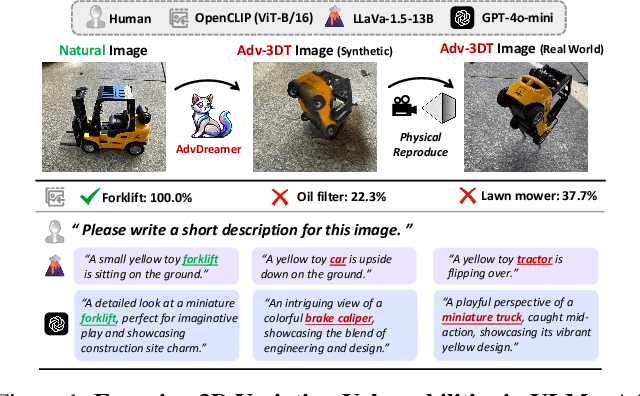
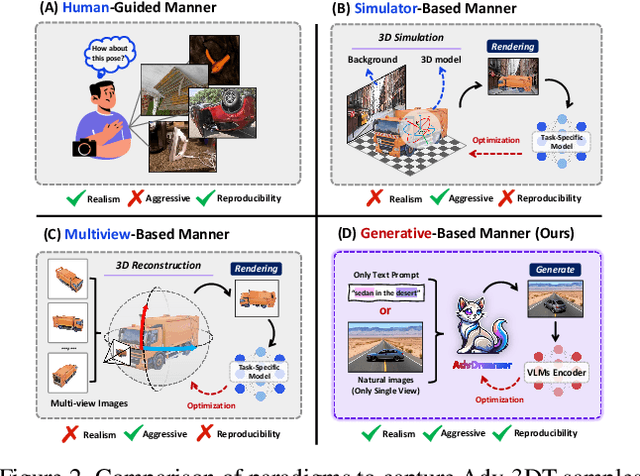
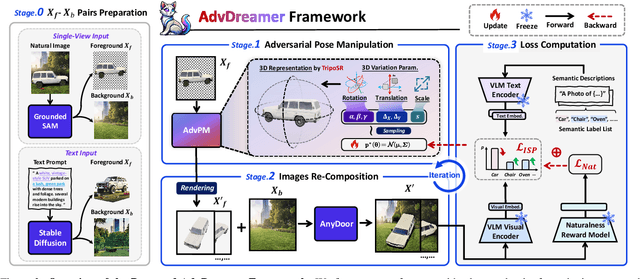
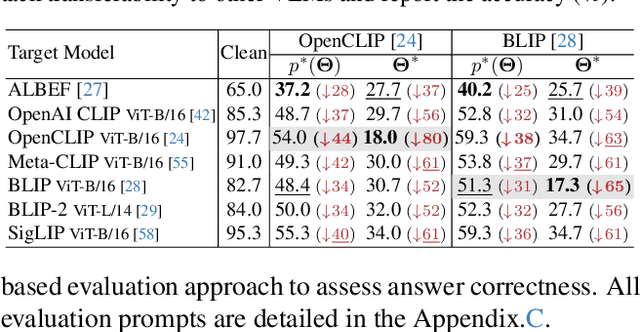
Abstract:Vision Language Models (VLMs) have exhibited remarkable generalization capabilities, yet their robustness in dynamic real-world scenarios remains largely unexplored. To systematically evaluate VLMs' robustness to real-world 3D variations, we propose AdvDreamer, the first framework that generates physically reproducible adversarial 3D transformation (Adv-3DT) samples from single-view images. AdvDreamer integrates advanced generative techniques with two key innovations and aims to characterize the worst-case distributions of 3D variations from natural images. To ensure adversarial effectiveness and method generality, we introduce an Inverse Semantic Probability Objective that executes adversarial optimization on fundamental vision-text alignment spaces, which can be generalizable across different VLM architectures and downstream tasks. To mitigate the distribution discrepancy between generated and real-world samples while maintaining physical reproducibility, we design a Naturalness Reward Model that provides regularization feedback during adversarial optimization, preventing convergence towards hallucinated and unnatural elements. Leveraging AdvDreamer, we establish MM3DTBench, the first VQA dataset for benchmarking VLMs' 3D variations robustness. Extensive evaluations on representative VLMs with diverse architectures highlight that 3D variations in the real world may pose severe threats to model performance across various tasks.
OODFace: Benchmarking Robustness of Face Recognition under Common Corruptions and Appearance Variations
Dec 03, 2024



Abstract:With the rise of deep learning, facial recognition technology has seen extensive research and rapid development. Although facial recognition is considered a mature technology, we find that existing open-source models and commercial algorithms lack robustness in certain real-world Out-of-Distribution (OOD) scenarios, raising concerns about the reliability of these systems. In this paper, we introduce OODFace, which explores the OOD challenges faced by facial recognition models from two perspectives: common corruptions and appearance variations. We systematically design 30 OOD scenarios across 9 major categories tailored for facial recognition. By simulating these challenges on public datasets, we establish three robustness benchmarks: LFW-C/V, CFP-FP-C/V, and YTF-C/V. We then conduct extensive experiments on 19 different facial recognition models and 3 commercial APIs, along with extended experiments on face masks, Vision-Language Models (VLMs), and defense strategies to assess their robustness. Based on the results, we draw several key insights, highlighting the vulnerability of facial recognition systems to OOD data and suggesting possible solutions. Additionally, we offer a unified toolkit that includes all corruption and variation types, easily extendable to other datasets. We hope that our benchmarks and findings can provide guidance for future improvements in facial recognition model robustness.
Real-world Adversarial Defense against Patch Attacks based on Diffusion Model
Sep 14, 2024Abstract:Adversarial patches present significant challenges to the robustness of deep learning models, making the development of effective defenses become critical for real-world applications. This paper introduces DIFFender, a novel DIFfusion-based DeFender framework that leverages the power of a text-guided diffusion model to counter adversarial patch attacks. At the core of our approach is the discovery of the Adversarial Anomaly Perception (AAP) phenomenon, which enables the diffusion model to accurately detect and locate adversarial patches by analyzing distributional anomalies. DIFFender seamlessly integrates the tasks of patch localization and restoration within a unified diffusion model framework, enhancing defense efficacy through their close interaction. Additionally, DIFFender employs an efficient few-shot prompt-tuning algorithm, facilitating the adaptation of the pre-trained diffusion model to defense tasks without the need for extensive retraining. Our comprehensive evaluation, covering image classification and face recognition tasks, as well as real-world scenarios, demonstrates DIFFender's robust performance against adversarial attacks. The framework's versatility and generalizability across various settings, classifiers, and attack methodologies mark a significant advancement in adversarial patch defense strategies. Except for the popular visible domain, we have identified another advantage of DIFFender: its capability to easily expand into the infrared domain. Consequently, we demonstrate the good flexibility of DIFFender, which can defend against both infrared and visible adversarial patch attacks alternatively using a universal defense framework.
The RoboDrive Challenge: Drive Anytime Anywhere in Any Condition
May 14, 2024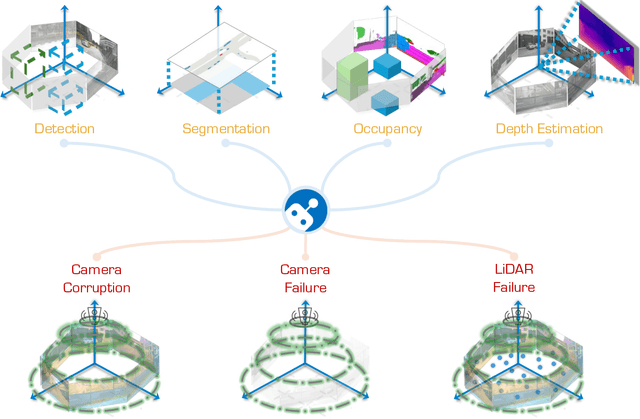


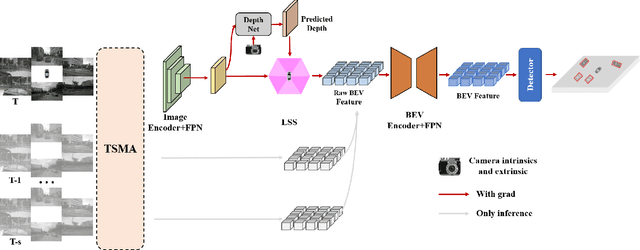
Abstract:In the realm of autonomous driving, robust perception under out-of-distribution conditions is paramount for the safe deployment of vehicles. Challenges such as adverse weather, sensor malfunctions, and environmental unpredictability can severely impact the performance of autonomous systems. The 2024 RoboDrive Challenge was crafted to propel the development of driving perception technologies that can withstand and adapt to these real-world variabilities. Focusing on four pivotal tasks -- BEV detection, map segmentation, semantic occupancy prediction, and multi-view depth estimation -- the competition laid down a gauntlet to innovate and enhance system resilience against typical and atypical disturbances. This year's challenge consisted of five distinct tracks and attracted 140 registered teams from 93 institutes across 11 countries, resulting in nearly one thousand submissions evaluated through our servers. The competition culminated in 15 top-performing solutions, which introduced a range of innovative approaches including advanced data augmentation, multi-sensor fusion, self-supervised learning for error correction, and new algorithmic strategies to enhance sensor robustness. These contributions significantly advanced the state of the art, particularly in handling sensor inconsistencies and environmental variability. Participants, through collaborative efforts, pushed the boundaries of current technologies, showcasing their potential in real-world scenarios. Extensive evaluations and analyses provided insights into the effectiveness of these solutions, highlighting key trends and successful strategies for improving the resilience of driving perception systems. This challenge has set a new benchmark in the field, providing a rich repository of techniques expected to guide future research in this field.
DIFFender: Diffusion-Based Adversarial Defense against Patch Attacks in the Physical World
Jun 15, 2023



Abstract:Adversarial attacks in the physical world, particularly patch attacks, pose significant threats to the robustness and reliability of deep learning models. Developing reliable defenses against patch attacks is crucial for real-world applications, yet current research in this area is severely lacking. In this paper, we propose DIFFender, a novel defense method that leverages the pre-trained diffusion model to perform both localization and defense against potential adversarial patch attacks. DIFFender is designed as a pipeline consisting of two main stages: patch localization and restoration. In the localization stage, we exploit the intriguing properties of a diffusion model to effectively identify the locations of adversarial patches. In the restoration stage, we employ a text-guided diffusion model to eliminate adversarial regions in the image while preserving the integrity of the visual content. Additionally, we design a few-shot prompt-tuning algorithm to facilitate simple and efficient tuning, enabling the learned representations to easily transfer to downstream tasks, which optimize two stages jointly. We conduct extensive experiments on image classification and face recognition to demonstrate that DIFFender exhibits superior robustness under strong adaptive attacks and generalizes well across various scenarios, diverse classifiers, and multiple attack methods.
Benchmarking Robustness of 3D Object Detection to Common Corruptions in Autonomous Driving
Mar 20, 2023Abstract:3D object detection is an important task in autonomous driving to perceive the surroundings. Despite the excellent performance, the existing 3D detectors lack the robustness to real-world corruptions caused by adverse weathers, sensor noises, etc., provoking concerns about the safety and reliability of autonomous driving systems. To comprehensively and rigorously benchmark the corruption robustness of 3D detectors, in this paper we design 27 types of common corruptions for both LiDAR and camera inputs considering real-world driving scenarios. By synthesizing these corruptions on public datasets, we establish three corruption robustness benchmarks -- KITTI-C, nuScenes-C, and Waymo-C. Then, we conduct large-scale experiments on 24 diverse 3D object detection models to evaluate their corruption robustness. Based on the evaluation results, we draw several important findings, including: 1) motion-level corruptions are the most threatening ones that lead to significant performance drop of all models; 2) LiDAR-camera fusion models demonstrate better robustness; 3) camera-only models are extremely vulnerable to image corruptions, showing the indispensability of LiDAR point clouds. We release the benchmarks and codes at https://github.com/kkkcx/3D_Corruptions_AD. We hope that our benchmarks and findings can provide insights for future research on developing robust 3D object detection models.
ViewFool: Evaluating the Robustness of Visual Recognition to Adversarial Viewpoints
Oct 08, 2022



Abstract:Recent studies have demonstrated that visual recognition models lack robustness to distribution shift. However, current work mainly considers model robustness to 2D image transformations, leaving viewpoint changes in the 3D world less explored. In general, viewpoint changes are prevalent in various real-world applications (e.g., autonomous driving), making it imperative to evaluate viewpoint robustness. In this paper, we propose a novel method called ViewFool to find adversarial viewpoints that mislead visual recognition models. By encoding real-world objects as neural radiance fields (NeRF), ViewFool characterizes a distribution of diverse adversarial viewpoints under an entropic regularizer, which helps to handle the fluctuations of the real camera pose and mitigate the reality gap between the real objects and their neural representations. Experiments validate that the common image classifiers are extremely vulnerable to the generated adversarial viewpoints, which also exhibit high cross-model transferability. Based on ViewFool, we introduce ImageNet-V, a new out-of-distribution dataset for benchmarking viewpoint robustness of image classifiers. Evaluation results on 40 classifiers with diverse architectures, objective functions, and data augmentations reveal a significant drop in model performance when tested on ImageNet-V, which provides a possibility to leverage ViewFool as an effective data augmentation strategy to improve viewpoint robustness.
 Add to Chrome
Add to Chrome Add to Firefox
Add to Firefox Add to Edge
Add to Edge